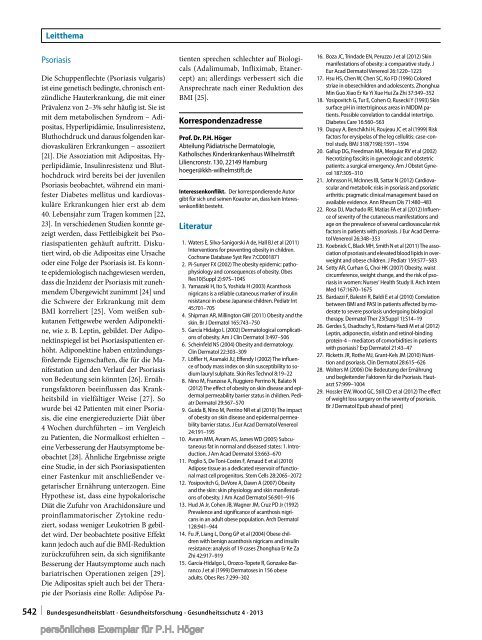Dermatologische Probleme bei Kindern mit Adipositas
Dermatologische Probleme bei Kindern mit Adipositas
Dermatologische Probleme bei Kindern mit Adipositas
Erfolgreiche ePaper selbst erstellen
Machen Sie aus Ihren PDF Publikationen ein blätterbares Flipbook mit unserer einzigartigen Google optimierten e-Paper Software.
Leitthema<br />
Psoriasis<br />
Die Schuppenflechte (Psoriasis vulgaris)<br />
ist eine genetisch bedingte, chronisch entzündliche<br />
Hauterkrankung, die <strong>mit</strong> einer<br />
Prävalenz von 2–3% sehr häufig ist. Sie ist<br />
<strong>mit</strong> dem metabolischen Syndrom – <strong>Adipositas</strong>,<br />
Hyperlipidämie, Insulinresistenz,<br />
Bluthochdruck und daraus folgenden kardiovaskulären<br />
Erkrankungen – assoziiert<br />
[21]. Die Assozia tion <strong>mit</strong> <strong>Adipositas</strong>, Hyperlipidämie,<br />
Insulinresistenz und Bluthochdruck<br />
wird bereits <strong>bei</strong> der juvenilen<br />
Psoriasis beobachtet, während ein manifester<br />
Diabetes mellitus und kardiovaskuläre<br />
Erkrankungen hier erst ab dem<br />
40. Lebensjahr zum Tragen kommen [22,<br />
23]. In verschiedenen Studien konnte gezeigt<br />
werden, dass Fettleibigkeit <strong>bei</strong> Psoriasispatienten<br />
gehäuft auftritt. Diskutiert<br />
wird, ob die <strong>Adipositas</strong> eine Ursache<br />
oder eine Folge der Psoriasis ist. Es konnte<br />
epidemiologisch nachgewiesen werden,<br />
dass die Inzidenz der Psoriasis <strong>mit</strong> zunehmendem<br />
Übergewicht zunimmt [24] und<br />
die Schwere der Erkrankung <strong>mit</strong> dem<br />
BMI korreliert [25]. Vom weißen subkutanen<br />
Fettgewebe werden Adiponektine,<br />
wie z. B. Leptin, gebildet. Der Adiponektinspiegel<br />
ist <strong>bei</strong> Psoriasispatienten erhöht.<br />
Adiponektine haben entzündungsfördernde<br />
Eigenschaften, die für die Manifestation<br />
und den Verlauf der Psoriasis<br />
von Bedeutung sein könnten [26]. Ernährungsfaktoren<br />
beeinflussen das Krankheitsbild<br />
in vielfältiger Weise [27]. So<br />
wurde <strong>bei</strong> 42 Patienten <strong>mit</strong> einer Psoriasis,<br />
die eine energie reduzierte Diät über<br />
4 Wochen durchführten – im Vergleich<br />
zu Patienten, die Normalkost erhielten –<br />
eine Verbesserung der Hautsymptome beobachtet<br />
[28]. Ähnliche Ergebnisse zeigte<br />
eine Studie, in der sich Psoriasis patienten<br />
einer Fastenkur <strong>mit</strong> anschließender vegetarischer<br />
Ernährung unterzogen. Eine<br />
Hypothese ist, dass eine hypokalorische<br />
Diät die Zufuhr von Arachidonsäure und<br />
proinflammatorischer Zytokine reduziert,<br />
sodass weniger Leukotrien B gebildet<br />
wird. Der beobachtete positive Effekt<br />
kann jedoch auch auf die BMI-Reduktion<br />
zurückzuführen sein, da sich signifikante<br />
Besserung der Hautsymp tome auch nach<br />
bariatrischen Operationen zeigen [29].<br />
Die <strong>Adipositas</strong> spielt auch <strong>bei</strong> der Therapie<br />
der Psoriasis eine Rolle: Adipöse Patienten<br />
sprechen schlechter auf Biologicals<br />
(Adalimumab, Infliximab, Etanercept)<br />
an; allerdings verbessert sich die<br />
Ansprechrate nach einer Reduktion des<br />
BMI [25].<br />
Korrespondenzadresse<br />
Prof. Dr. P.H. Höger<br />
Abteilung Pädiatrische Dermatologie,<br />
Katholisches Kinderkrankenhaus Wilhelmstift<br />
Liliencronstr. 130, 22149 Hamburg<br />
hoeger@kkh-wilhelmstift.de<br />
Interessenkonflikt. Der korrespondierende Autor<br />
gibt für sich und seinen Koautor an, dass kein Interessenkonflikt<br />
besteht.<br />
Literatur<br />
1. Waters E, Silva-Sanigorski A de, Hall BJ et al (2011)<br />
Interventions for preventing obesity in children.<br />
Cochrane Database Syst Rev 7:CD001871<br />
2. Pi-Sunyer FX (2002) The obesity epidemic: pathophysiology<br />
and consequences of obesity. Obes<br />
Res10(Suppl 2):97S–104S<br />
3. Yamazaki H, Ito S, Yoshida H (2003) Acanthosis<br />
nigricans is a reliable cutaneous marker of insulin<br />
resistance in obese Japanese children. Pediatr Int<br />
45:701–705<br />
4. Shipman AR, Millington GW (2011) Obesity and the<br />
skin. Br J Dermatol 165:743–750<br />
5. García Hidalgo L (2002) Dermatological complications<br />
of obesity. Am J Clin Dermatol 3:497–506<br />
6. Scheinfeld NS (2004) Obesity and dermatology.<br />
Clin Dermatol 22:303–309<br />
7. Löffler H, Aramaki JU, Effendy I (2002) The influence<br />
of body mass index on skin susceptibility to sodium<br />
lauryl sulphate. Skin Res Technol 8:19–22<br />
8. Nino M, Franzese A, Ruggiero Perrino N, Balato N<br />
(2012) The effect of obesity on skin disease and epidermal<br />
permeability barrier status in children. Pediatr<br />
Dermatol 29:567–570<br />
9. Guida B, Nino M, Perrino NR et al (2010) The impact<br />
of obesity on skin disease and epidermal permeability<br />
barrier status. J Eur Acad Dermatol Venereol<br />
24:191–195<br />
10. Avram MM, Avram AS, James WD (2005) Subcutaneous<br />
fat in normal and diseased states: 1. Introduction.<br />
J Am Acad Dermatol 53:663–670<br />
11. Poglio S, De Toni-Costes F, Arnaud E et al (2010)<br />
Adipose tissue as a dedicated reservoir of functional<br />
mast cell progenitors. Stem Cells 28:2065–2072<br />
12. Yosipovitch G, DeVore A, Dawn A (2007) Obesity<br />
and the skin: skin physiology and skin manifestations<br />
of obesity. J Am Acad Dermatol 56:901–916<br />
13. Hud JA Jr, Cohen JB, Wagner JM, Cruz PD Jr (1992)<br />
Prevalence and significance of acanthosis nigricans<br />
in an adult obese population. Arch Dermatol<br />
128:941–944<br />
14. Fu JF, Liang L, Dong GP et al (2004) Obese children<br />
with benign acanthosis nigricans and insulin<br />
resistance: analysis of 19 cases Zhonghua Er Ke Za<br />
Zhi 42:917–919<br />
15. García-Hidalgo L, Orozco-Topete R, Gonzalez-Barranco<br />
J et al (1999) Dermatoses in 156 obese<br />
adults. Obes Res 7:299–302<br />
16. Boza JC, Trindade EN, Peruzzo J et al (2012) Skin<br />
manifestations of obesity: a comparative study. J<br />
Eur Acad Dermatol Venereol 26:1220–1223<br />
17. Hsu HS, Chen W, Chen SC, Ko FD (1996) Colored<br />
striae in obesechildren and adolescents. Zhonghua<br />
Min Guo Xiao Er Ke Yi Xue Hui Za Zhi 37:349–352<br />
18. Yosipovitch G, Tur E, Cohen O, Rusecki Y (1993) Skin<br />
surface pH in intertriginous areas in NIDDM patients.<br />
Possible correlation to candidal intertrigo.<br />
Diabetes Care 16:560–563<br />
19. Dupuy A, Benchikhi H, Roujeau JC et al (1999) Risk<br />
factors for erysipelas of the leg cellulitis: case-control<br />
study. BMJ 318(7198):1591–1594<br />
20. Gallup DG, Freedman MA, Meguiar RV et al (2002)<br />
Necrotizing fasciitis in gynecologic and obstetric<br />
patients: a surgical emergency. Am J Obstet Gynecol<br />
187:305–310<br />
21. Johnsson H, McInnes IB, Sattar N (2012) Cardiovascular<br />
and metabolic risks in psoriasis and psoriatic<br />
arthritis: pragmatic clinical management based on<br />
available evidence. Ann Rheum Dis 71:480–483<br />
22. Rosa DJ, Machado RF, Matias FA et al (2012) Influence<br />
of severity of the cutaneous manifestations and<br />
age on the prevalence of several cardiovascular risk<br />
factors in patients with psoriasis. J Eur Acad Dermatol<br />
Venereol 26:348–353<br />
23. Koebnick C, Black MH, S<strong>mit</strong>h N et al (2011) The association<br />
of psoriasis and elevated blood lipids in overweight<br />
and obese children. J Pediatr 159:577–583<br />
24. Setty AR, Curhan G, Choi HK (2007) Obesity, waist<br />
circumference, weight change, and the risk of psoriasis<br />
in women: Nurses‘ Health Study II. Arch Intern<br />
Med 167:1670–1675<br />
25. Bardazzi F, Balestri R, Baldi E et al (2010) Correla tion<br />
between BMI and PASI in patients affected by moderate<br />
to severe psoriasis undergoing biological<br />
therapy. Dermatol Ther 23(Suppl 1):S14–19<br />
26. Gerdes S, Osadtschy S, Rostami-Yazdi M et al (2012)<br />
Leptin, adiponectin, visfatin and retinol-binding<br />
protein-4 – mediators of comorbidities in patients<br />
with psoriasis? Exp Dermatol 21:43–47<br />
27. Ricketts JR, Rothe MJ, Grant-Kels JM (2010) Nutrition<br />
and psoriasis. Clin Dermatol 28:615–626<br />
28. Wolters M (2006) Die Bedeutung der Ernährung<br />
und begleitender Faktoren für die Psoriasis. Hautarzt<br />
57:999–1004<br />
29. Hossler EW, Wood GC, Still CD et al (2012) The effect<br />
of weight loss surgery on the severity of psoriasis.<br />
Br J Dermatol Epub ahead of print]<br />
542 | Bundesgesundheitsblatt - Gesundheitsforschung - Gesundheitsschutz 4 · 2013










